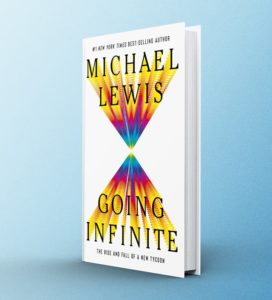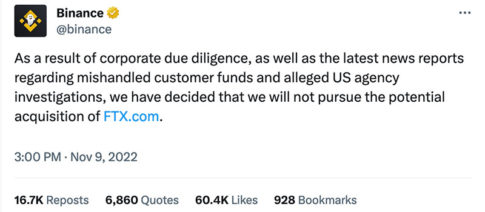The Book: “Going Infinite: The Rise and Fall of a New Tycoon”
Published: October 3, 2023
By: Michael Lewis is a contributing editor for Vanity Fair and a best-selling author known for reporting on business, finance and banking.
He is the author of “Liar’s Poker,” a first-person view of his experience as a stockbroker in the 1980s; “Moneyball,” an account of the Oakland Athletics baseball team’s 2002 season, and “The Big Short,” which chronicled the buildup to the housing bubble in 2008. The latter two were made into movies.
Why We Picked It: “Going Infinite” may be the hottest financial business book of the year. But some critics have charged that Lewis became too close to his subject and is enamored of a man accused of breathtaking fraud. The Financial Brand did a close reading and our verdict follows.

Move the Needle from Attrition to Acquisition
Vericast’s 2024 Financial TrendWatch explores seven of today’s most critical financial services trends to provide a complete view of the current loyalty landscape.
Read More about Move the Needle from Attrition to Acquisition

Are You Ready for a Digital Transformation?
Unlock the potential of your financial institution's digital future with Arriba Advisors. Chart a course for growth, value and superior customer experiences.
Executive Summary
“Going Infinite: The Rise and Fall of a New Tycoon” chronicles the rapid rise and fall of FTX, the now-bankrupt cryptocurrency exchange co-founded by Sam Bankman-Fried (also referred to as “SBF”) and Gary Wang. During its peak in mid-2021, FTX was one of the largest cryptocurrency exchanges in the world, with over 5 million active users and a daily trading volume of $12 billion.
 Michael Lewis shadowed Bankman-Fried for nearly a year, coinciding with the peak and collapse of FTX. The rapid success of FTX began to unravel in November 2022 when a leaked balance sheet showed Bankman-Fried’s other company, Alameda Research, was holding billions of dollars of FTX customer funds.
Michael Lewis shadowed Bankman-Fried for nearly a year, coinciding with the peak and collapse of FTX. The rapid success of FTX began to unravel in November 2022 when a leaked balance sheet showed Bankman-Fried’s other company, Alameda Research, was holding billions of dollars of FTX customer funds.
Lewis digs deep into Bankman-Fried’s early childhood, thought process and motivations. Throughout “Going Infinite,” he characterizes Bankman-Fried as an altruistic “math nerd” whose greatest skill is calculating real-time probabilities based on changing conditions.
The author notes Bankman-Fried’s poor interpersonal skills and FTX’s lack of leadership and organizational structure. “Going Infinite” largely leaves it to the reader to decide if Bankman-Fried was an evil genius or a naïve entrepreneur whose balance sheet rapidly outgrew his leadership skills.
“In a lot of ways, I don’t really have a soul. There’s a pretty decent argument that my empathy is fake, my feelings are fake, my facial reactions are fake. I don’t feel happiness.”
— Sam Goodman-Fried in a note to his girlfriend, as reported by Lewis

Key Takeaways from the Book
• At FTX’s peak in July 2021, Forbes noted Bankman-Fried’s $22.5 billion net worth made him the wealthiest person in the world under 30.
• Lewis notes every facet of Bankman-Fried’s life — business meetings, investments, personal relationships — is driven by gamified quantitative analyses that constantly weigh his risk and reward.
• Bankman-Fried faces seven federal charges that could land him a 100-year prison sentence. Several FTX colleagues, including his on-again, off-again girlfriend who headed Alameda Research, have pleaded guilty and turned government witnesses.
What We Liked: Prior to FTX’s highly publicized collapse, the public knew little about Bankman-Fried. In he months Lewis spent with him in his compound, he got a first-hand account of Bankman-Fried’s upbringing and a look at his business and personal life. Lewis also offers a lot of background on cryptocurrency, giving readers a clear picture of how Bankman-Fried’s company grew so rapidly.
What We Didn’t Like: On the evidence here, Bankman-Fried is perhaps the world’s most boring billionaire. The first few chapters of “Going Infinite” work overtime to paint him as magical and methodical. Characterized as “eccentric” because he wears T-shirts and cargo pants and has an untraditional management style, he ultimately comes across as soulless, with little substance beyond a love for math camp and video games.
His self-professed lack of people skills and naïve view of the world may leave readers with more pity than admiration or even anger. While the book picks up in the end, the first few chapters are a challenge to get through.
Things That Made Us Go Hmm: Throughout, Lewis refers to Bankman-Fried and his colleagues as “the altruists,” while knowing the end game sucked investors dry of billions. Several reviews — including those in The New York Times, Los Angeles Times, and The Atlantic — have questioned Lewis’ reporting, suggesting he got too close to Bankman-Fried. Lewis did acknowledge that Bankman-Fried would occasionally ask him for advice, in an October 2023 interview on “60 Minutes.”
Sam Bankman-Fried’s Backstory
Bankman-Fried is the son of two Stanford professors. After graduating from MIT in 2014, he worked for Jane Street Capital, the New York-based global trading firm, where his quick calculations and risk analysis helped him excel.
He left Jane Street and eventually founded the Alameda Research hedge fund in 2017 to buy and sell bitcoin. Bankman-Fried recruited 20 young people with no experience in trading or cryptocurrency to work there and took an unorthodox approach to business with little traditional structure. Alameda began making successful and lucrative arbitrage trades and in 2019 the company moved from California to Hong Kong.
That same year, Bankman-Fried started his own crypto exchange under the name FTX. It grew quickly, raising nearly $1 billion in July 2021 from prominent investors, including Softbank and Sequoia Capital.
The Struggle with Emotion: During his first job at Jane Street, Bankman-Fried had to practice facial expressions and “teach himself to smile.” His constant leg jittering and avoidance of eye contact often created an emotional distance between himself and others.
Buying Credibility: FTX spent its way to notoriety by pouring cash into celebrity endorsements and marketing. FTX purchased the naming rights to the Miami Heat stadium for $135 million in 2021. It also paid Tom Brady $55 million for 20 hours of his time in marketing efforts and spent $6.5 million on a 30-second Super Bowl commercial.
Effective Altruism: Bankman-Fried claimed to be driven by “effective altruism,” a philosophy that focuses on maximizing the impact of charitable giving. While he did own real estate deals worth nearly $300 million in the Bahamas, he also lived in wrinkled t-shirts, regularly slept in his office and passed on the yachts and Lamborghinis most 30-year-old, single, male billionaires might seek. According to the book, Bankman-Fried believed earning more enabled him to give more and make a bigger impact on the world. His most important causes were pandemic preparation, climate change and a campaign to keep Donald Trump from running for president.
Politics: Bankman-Fried was the second largest donor to the Biden campaign in 2020 and the second-largest individual donor to the Democratic cause for the 2022 U.S. elections, contributing nearly $40 million. In May 2022, he said he planned to donate up to $1 billion in the 2024 presidential election. Lewis says Bankman-Fried also considered paying Trump $5 billion not to run for president in 2024.
Read more:
- Fintechs, Walmart and Crypto: A Venture Capital Firm’s Take
- Outlook for U.S. Central Bank Digital Currency Is Dim

Where Bankman-Fried and FTX Are Now
The Short Version of the Collapse: FTX’s unraveling began on November 2, 2022, when Coindesk reported on a leaked balance sheet indicating nearly $9 billion in FTX customers’ money was in Alemeda Research. Binance’s Chief Executive, Changpeng Zhao, then Tweeted his firm’s intent to sell its holdings of FTX’s tokens, called FTT, which started a run on the platform. SBF offered to sell FTX to Binance, but the deal fell apart.
When Zhao tweeted that his company would not pursue the potential acquisition of FTX, remaining customers scrambled to withdraw funds, and the exchange collapsed. FTX, Alameda Research and 130 other associated entities declared bankruptcy on November 11, 2022. SBF’s net worth plummeted 95% in one day.
The Hammer Falls: Bankman-Fried was arrested in the Bahamas on December 12, 2022 and extradited to the U.S. He was released on a $250 million bond — the largest in American history — on the terms that he reside with his parents. A judge revoked his bond in August 2023 after accusations that he had attempted to influence witnesses.
The Case: As of October 2023, Bankman-Fried is on trial in Manhattan federal court on seven counts, including wire fraud, conspiracy to commit wire fraud, conspiracy to commit securities fraud and conspiracy to commit money laundering. If convicted, he could be sentenced to more than 100 years in prison.
Leadership? What Leadership?: FTX had no traditional structure or leadership. There were no C-suite titles, no CFO, HR department, compliance department, or board of directors. Instead, the company was comprised of “executive assistants” who had vague job descriptions. Lewis notes Bankman-Fried often played video games while on important calls.
Friends Become Foes: Several of Bankman-Fried’s friends and FTX leadership have accepted plea deals and become federal witnesses. Bankman-Fried’s ex-girlfriend and head of Alameda Research, Caroline Ellison, dropped some bombshell testimony, saying he “directed” her to use customers’ money to repay risky loans.
See all of our latest coverage about crypto for the banking industry.

The Final Verdict
Bankman-Fried’s trial has only started, so a final verdict has yet to be read. Lewis himself leaves it up to the reader to decide culpability for the collapse. “Going Infinite” doesn’t ascribe any ill intent to Bankman-Fried, but it does make the case for wanton negligence and business mismanagement.








